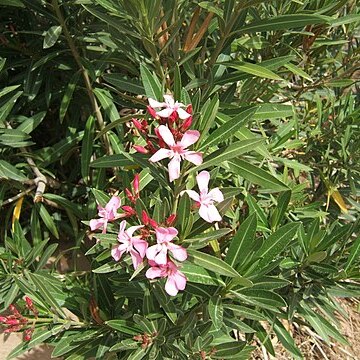Trees or shrubs, evergreen, juice watery. Leaves in whorls of 3, midvein prominent abaxially, lateral veins numerous, parallel. Inflorescences corymbose, terminal. Corolla funnelform, cylindric near base, throat open, wide, lobes overlapping to right; corona segments 5, petal-like, large, fringed. Stamens inserted at apex of corolla tube; anthers sagittate, with a bristly, filiform apical appendage, pilose, connivent, adherent to pistil head; disc absent. Ovaries 2, distinct; ovules numerous in each locule. Follicles united until just before dehiscence. Seeds numerous, densely pilose, coma at truncate apex.
Evergreen shrubs or small trees. Sap not milky. Lvs opposite or in whorls of 3-4; stomata in pits on lower surface. Fls in terminal branched cymes, large, 5-merous. Calyx lobed almost to base. Corolla funnelform, with a corona of 5 laciniate or dentate scale-like appendages in the widely open throat; lobes spreading, twisted clockwise in bud. Stamens included, inserted near corolla throat; filaments very short; anthers connivent, with long, apical, hairy, twisted awns. Disc glands 0. Fr. a pair of long slender follicles. Seeds with apical coma of hairs.
Shrubs or small trees, lacticiferous. Leaves ternate, quaternate, or sometimes opposite, non-glandular, coriaceous; petiolate or subsessile, mostly glandular in the axils. Inflorescences thyrisform, terminal, many-flowered. Flowers showy, medium-sized; calyx 5-lobed, the lobes ? equal, mostly imbricate, bearing many squamellae within; corolla infundibuliform, the throat with 5-cleft petaloid ap-pendages, the limb 5-lobed, the lobes dextrorsely convolute; stamens 5, slightly
exserted, the anthers connivent and agglutinated to the stigma; gynoecium 2-carpellate, apocarpous, the ovary superior, the ovules many, without a nectary, the style 1, the stigma fusiform. Fruit apocarpous, of 2 follicles, ? stout; seeds many, dry, compressed, densely puberulent, comose apically.

